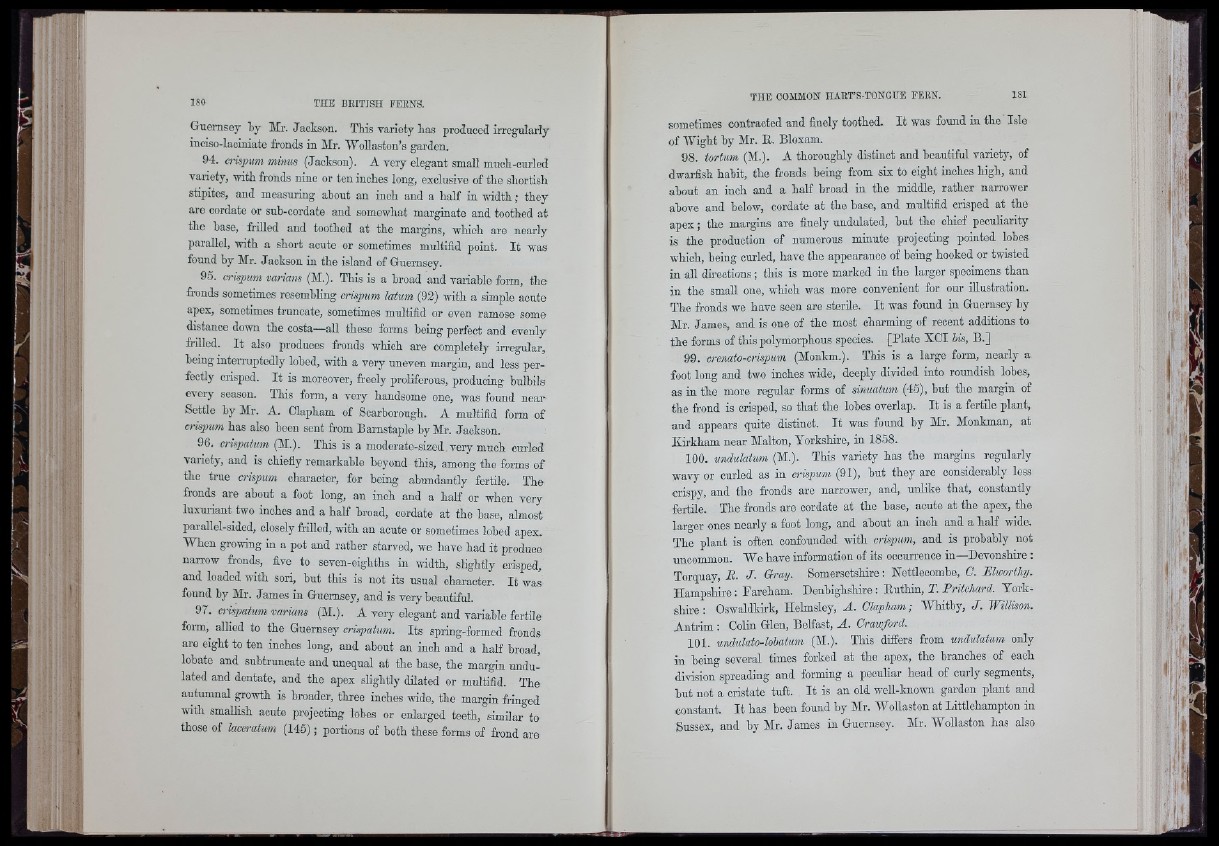
lAh
ill
'!]/■
- i i .
■i;'
l> I >9
A'.
¿1
it
■ k i
■ M .
:|i:|
’¡ti •
V i
I ' *'
■i
Guernsey by Mr. J aokson. This variety has produced irregularly
inciso-laoiniate fronds in Mr. AYollaston’s garden.
94. crispum minus (Jackson). A very elegant small much-curled
variety, with fronds nine or ten inches long, exclusive of the shortish
stipites, and measuring about an inch and a half in width; they
are cordate or suh-cordate and somewhat marginate and toothed at
the base, frilled and toothed at the margins, which are nearly
parallel, with a short acute or sometimes multifid point. It was
found by Air. Jackson in the island of Guernsey.
95. crisptm mrians (AI.). This is a broad and variable form, the
fronds sometimes rcsemhhng crispum latum (92) with a simple acute
apex, sometimes truncate, sometimes multifid or even ramose some
distance down the oosta—aU these forms being perfect and evenly
frilled. It also produces fronds which are completely irregular,
being interruptedly lobed, with a very uneven margin, and less perfectly
crisped. It is moreover, freely proliferous, producing bulbils
every season. This form, a very handsome one, was found near
Settle by Air. A. Clapham of Scarborough. A multifid form of
crispum has also been sent fi-om Barnstaple by Air. Jackson.
96. cnspatum (AI.). This is a moderate-sized. very much curled
variety, and is chiefiy remarkable beyond this, among the forms of
the true crispum character, for being abundantly fertile. The
fronds are about a foot long, an inch and a half or when very
luxuriant two inches and a half broad, cordate at the base, almost
parallel-sided, closely frilled, with an acute or sometimes lobed apex.
AVhen growing in a pot and rather starved, we have had it produce
narrow fi-onds, five to seven-eighths in width, slightly crisped,
and loaded with sori, hut this is not its usual character. It was
fonnd by Air. James in Guernsey, and is very beautiful.
97. crispatum varians (AI.). A veiy elegant and variable fertile
form, allied to the Guernsey crispatum. Its spring-formed fronds
are eight to ten inches long, and about an inch and a half broad,
lohate and subtruneate and unequal at the base, the margin u n d l
lated and dentate, and the apex slightly dilated or multifid. The
autumnal growth is broader, three inches wide, the margin fringed
with smaUish acute projecting lobes or enlarged teeth, similar to
those of laceratum (145); portions of both these forms of frond are
sometimes contracted and finely toothed. It was found in the Isle
of AVight by Air. B,. Bloxam.
98. tortum (AI.). A thoroughly distinct and beautiful variety, of
dwarfish habit, the fronds heing from six to eight inches high, and
about an inch and a half broad in the middle, rather narrower
above and below, cordate at the base, and multifid crisped at the
apex; the margins are finely undulated, but tho chief peculiarity
is the production of numerous minute projecting pointed lobes
which, being curled, have the appearance of being hooked or twisted
in all directions; this is moro marked in the larger specimens than
in the small one, which was more convenient for our illustration.
The fronds we have seen are sterile. It was found in Guernsey by
Air. James, and is one of the most charming of recent additions to
the forms of this polymorphous species. [Plate XCI bis, B.]
99. erenato-erispum (Alonkm.). This is a large form, nearly a
foot long and two inches wide, deeply divided into roundish lobes,
as in the more regular forms of sinuatum (45), but the margin of
the frond is crisped, so that the lobes overlap. It is a fertile plant,
and appears quite distinct. It was found by Air. Alonkman, at
Kirkham near Alalton, Yorkshire, in 1858.
100. unduMum (AI.). This variety has the margins regularly
wav}” or curled as in erispum (91), but they are considerably less
crispy, and the fronds are narrower, and, unlike that, constantly
fertile. The fronds are cordate at the base, acute at the apex, the
larger ones nearly a foot long, and about an inch and a half wide.
The plant is often confounded with crispum, and is probably not
uncommon. AVe have information of its ocourrence in—Devonshire :
Torquay, R. J- Gray. Somersetshire: Nettlecombe, C. Elworthy.
Hampshire; Fareham. Denbighshire: Ruthin, T. Pritchard. Yorkshire
: Oswaldkirk, Helmsley, A. Clapham; AATuthy, J. Willison.
Antrim : Colin Glen, Belfast, A. Crawford.
101. undulato-lohatum (AI.). This differs from undulatum only
in being several times forked at the apex, the branches of each
division spreading and forming a peculiar head of curly segments,
bnt not a cristate tuft. It is an old well-known garden plant and
constant. It has been found by Air. AVollaston at Littlehampton in
Sussex, and by Air. James in Guernsey. Air. AVollaston has also
c
il
’ ' I
il
5'<r
f:|
I- >1
k;|j
Vi
r i i
ri:/
y
^ i )
: ■-AJ